MiGs, Stars & Magic Books: A Brief History of Trespassing in Moscow
An illustrated guide to urban exploration in the Russian capital.

23 April 2015
I’m embarrassed to say that my curiosity about Haitian vodou was the only reason I went to Port-au-Prince. Embarrassed, mainly, because I know the majority of Haitians would hate to hear it. It’s true, though – and worse yet, vodou was pretty much the only thing I knew about Haiti before my visit.
That did of course leave a lot of space for things I didn’t know, so I was eager to be surprised; and, in my week exploring Haiti – from the capital, Port-au-Prince, to some of the smaller towns and settlements around the mountains in the south of the country – my eyes were opened to a broad spectrum of culture, heritage, history and tradition.
But this post is still going to be about Haitian vodou.
There’s plenty more I plan to share from my time in Haiti, and in time I will. I’m going to start at the beginning however, by answering the questions that drove me there in the first place: is ritualistic vodou still practiced in modern-day Haiti? And is it really as bloody, as macabre and as terrifying as it is generally portrayed?
The short answer to both questions is Yes.
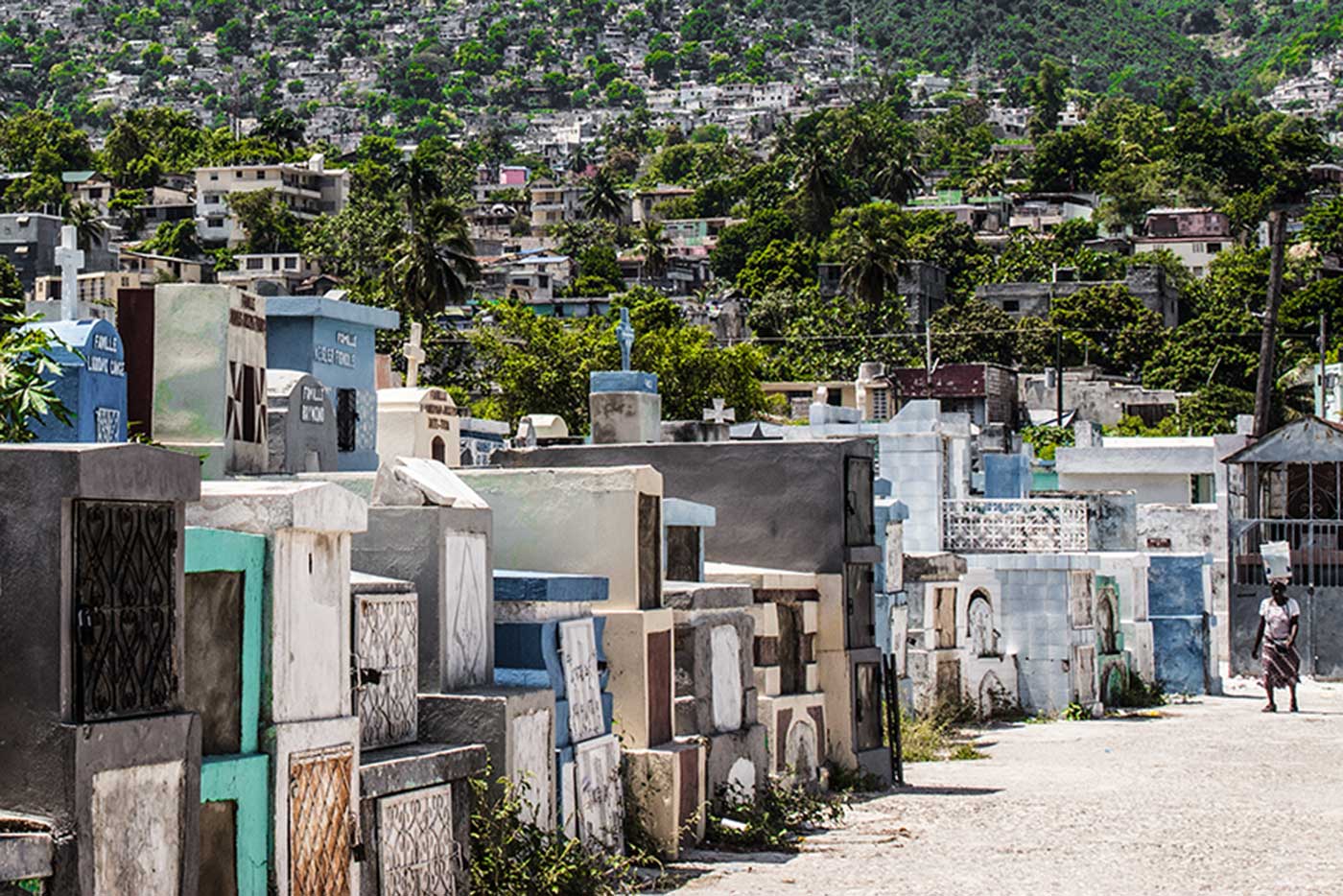
I usually like to travel on my own. I find I see more that way – I’m quieter, more discreet, I’m independent and focussed purely on my surroundings. There are times, however, when I’ll make an exception and join up with a tour group. Sometimes it’s the only option going; like in North Korea, where a state-approved tour is usually the only way to gain access to the country. Other times it can mean covering more ground. With hindsight, I almost wish I’d found one when I visited Kazakhstan: in a massive country with terrible public transport networks, there’s something to be said for a pre-booked itinerary and a chartered coach.
In Haiti it was a combination of factors that led me to join such a group. I was aware that I knew nothing about the place, and that getting to the good stuff might happen faster with a guide. Besides, I’d had so many people warn me about the various perceived dangers of visiting Haiti, that I was happy to sound it out from the comfort of a tour group, at least until I had a better feel for the place.
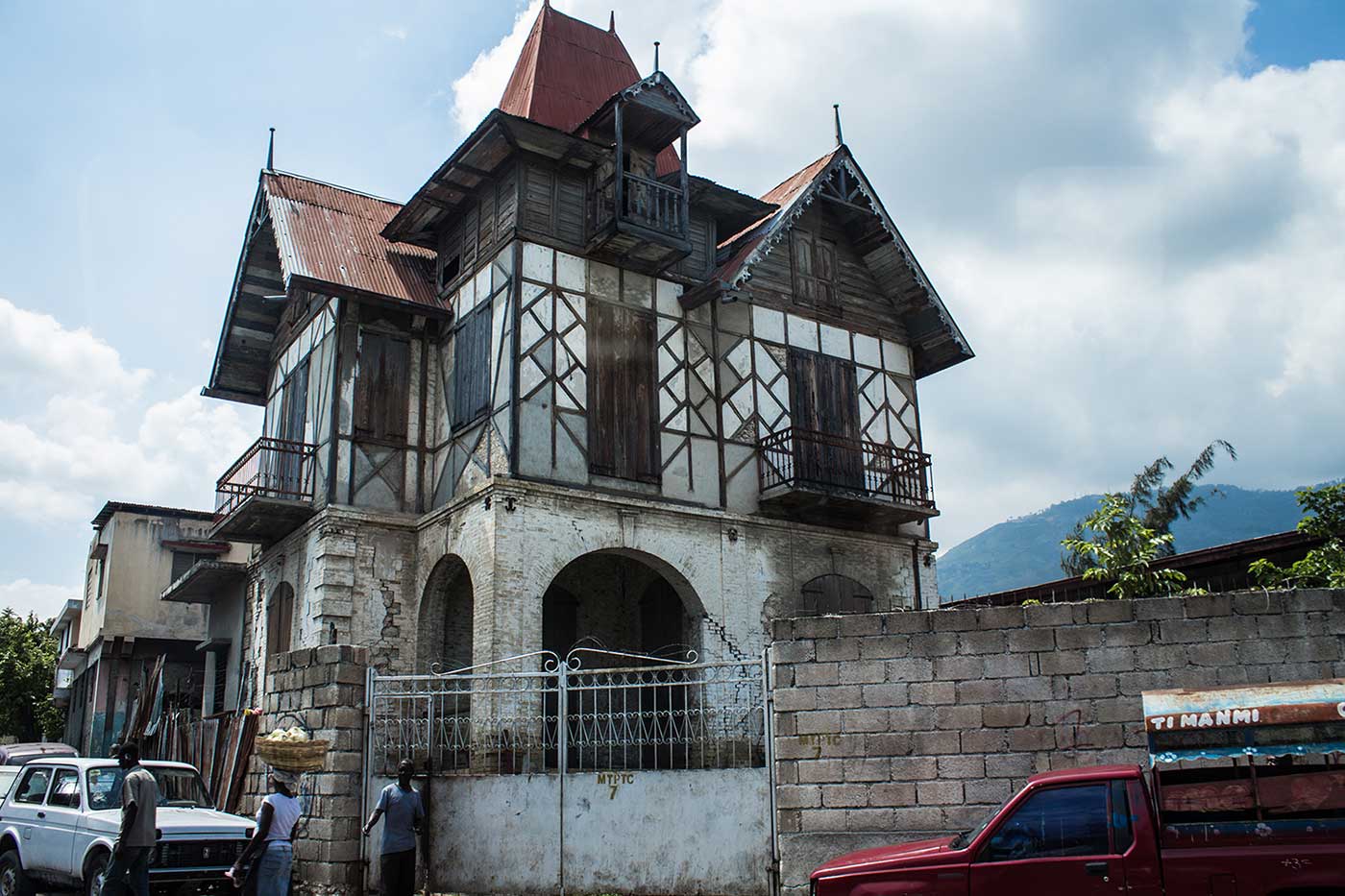
The tour began, in logical fashion, with a walk around the centre of the capital: Port-au-Prince. As it turned out though, we’d spend more time in the minibus than on foot. Our guide for the day was a young Haitian man; polite but distant, welcoming, but by no means confident in his role as cultural ambassador. He would point out key landmarks through the windows of the bus… take us to a museum or a monument, then rush us back to the vehicle before we could be completely engulfed by the noisy mob who crowded about us, hawking their painted, carved or metallurgic wares. The eight of us were the only white faces we saw in the city centre that day – and every Haitian with something to sell had us in their sights.

Even at our guest house – a Christian-mission-cum-youth-hostel in the slightly more well-to-do Delmas district of the capital – we couldn’t make it from our beds to the breakfast table without being cornered by souvenir salesmen.
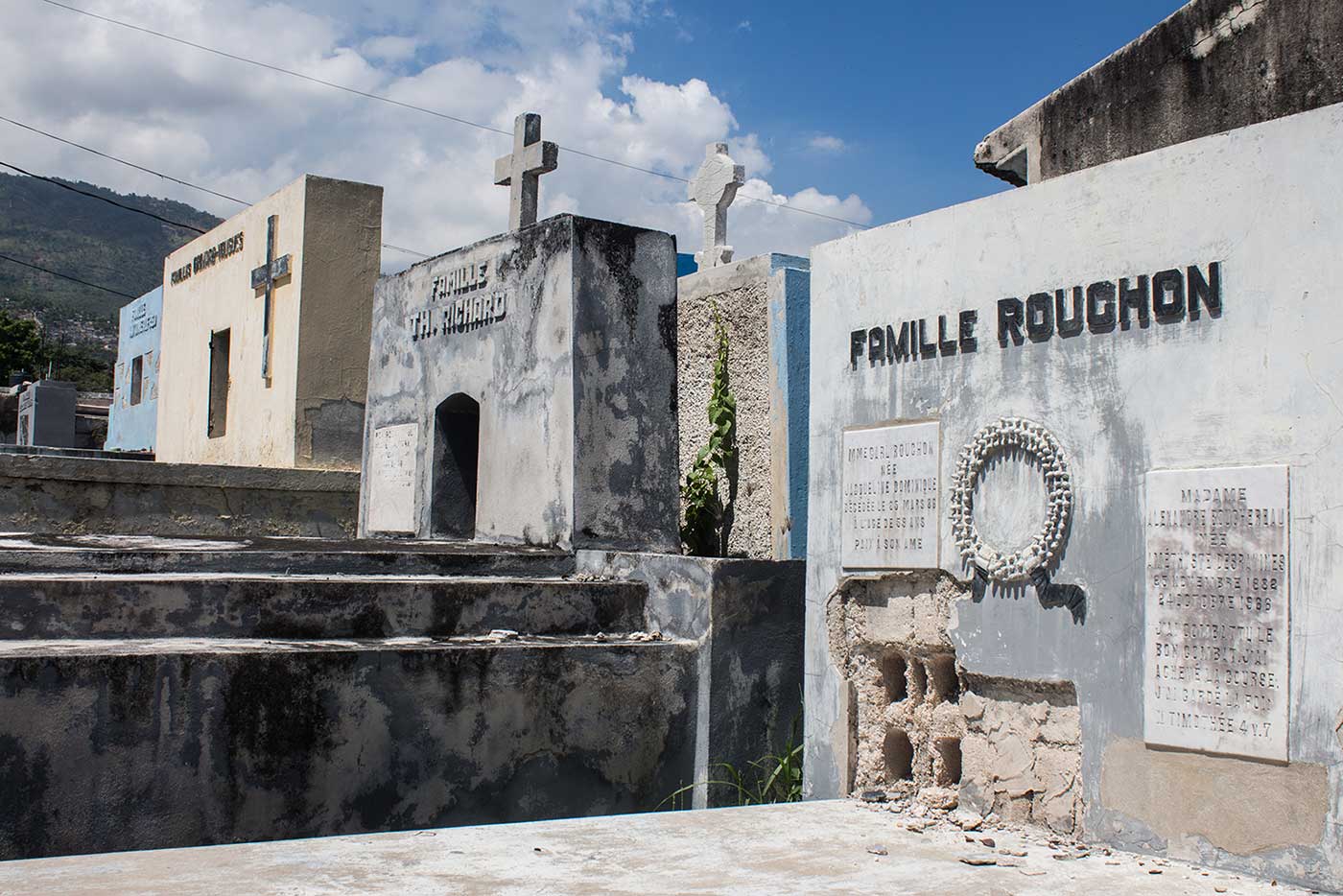
“My friend, my friend!” they would always start, “just a minute…” before launching into their pitch over a blanket spread with handicrafts and trinkets, hand-stitched garments, painted landscapes, and a smorgasbord of great big wooden phalluses. The people here were friendly, aggressively so, and not for a moment did I sense even the slightest hint of danger; so as our guide ferried us nervously from one location to the next, minimising our contact with the locals, carefully deflecting questions with his polite yet insistent commands to return to the safety of the vehicle, I wondered what he thought was going to happen to us.
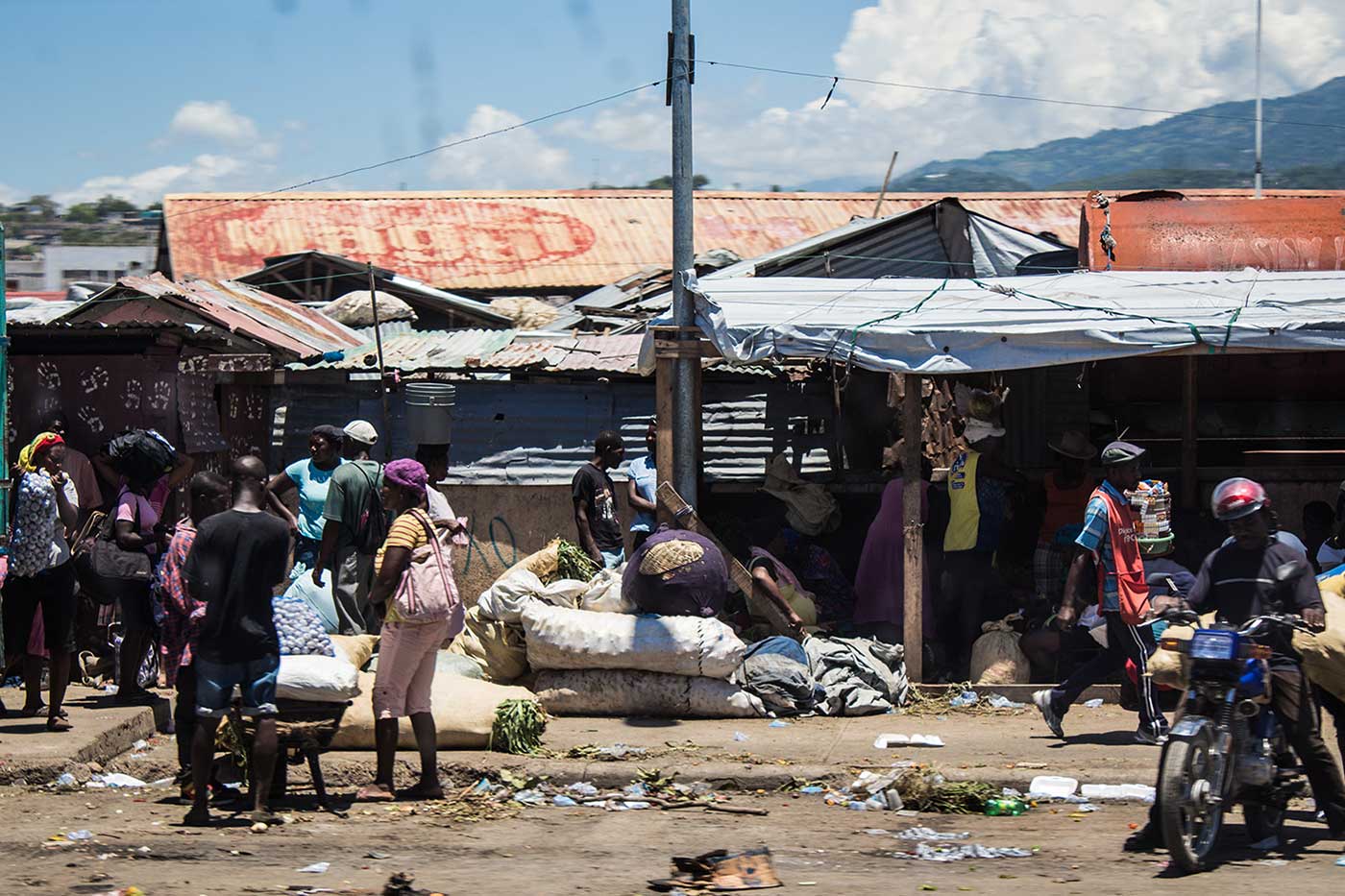
Later that night, I decided to put it to the test – slipping out of the guesthouse to walk alone through the streets of Port-au-Prince.
Even in the dark, tripping on rough pavements thanks to the lack of streetlights, I was aware of being watched. One stray foreigner roaming the night markets, picking up street food, asking for directions, seemed positively unheard of here. Not that it bothered me; I’ve travelled enough that I’m used to being the odd one out. The only thing that worried me was the machetes.
The Haitians seem to have a particular love for the machete. These deadly tools are carried openly, and they fill a surprising number of practical roles: I passed street vendors slicing their meat, or opening coconuts with a single slash. I saw older Haitians, leaning on their blades as though they were walking sticks. In a supermarket, another day, I’d see a clerk stacking high shelves full of tins, arranging them into neat and orderly rows using the tip of a two-foot blade. A few aisles over, a plastic oil drum served as a dispenser filled with price-tagged, ready-to-buy machetes.
Walking through the marketplace that night, it was hard not to stare at the glinting blades I passed. It didn’t help that the men who sat polishing them, sharpening them, or swinging them as they walked, invariably had their eyes focussed squarely on me: after all, I don’t exactly look much like a Haitian.

They were curious, of course, and legitimately so; but there is a strong precedent for the Haitian machete to double as a weapon. As recently as the 1960s and 70s, the ‘Tonton Macoute’ – a notorious paramilitary force under Haitian dictator François ‘Papa Doc’ Duvalier – were using their machetes to dismember the enemies of the regime before hanging their body parts from trees on public display. Earlier still, the machete played a crucial role in the Haitian Revolution of 1791–1804, and many a white colonist lost their head to one of these swinging blades.
Reflecting on that night now, I’m fairly confident that I was never in any danger. Over the course of the week to come almost every Haitian I spoke to was gracious, accommodating, and thoroughly likeable… but still the curious eyes, the sound of sharpening blades, I’ll confess, left me with a subtle yet unshakeable sense of dread. Good people or not, this was a country struck by poverty, famine and disease; and desperation drives people to extreme acts.
I returned to the guesthouse a few hours later, tired, dehydrated, and relieved to be back beneath an electric fan – but I still hadn’t seen any Haitian vodou. Or nothing, at least, that struck me as any way authentic.

So here’s the thing: vodou is everywhere in Haiti, and yet it is nowhere to be seen. The souvenir markets overflow with fetishes and charms, while the ‘vévé’ – summoning sigils of the vodou spirits, or ‘loa’ – appear carved into trees and painted onto backstreet walls. Actual practice of Haitian vodou though, the ritualistic performance of vodou rites as opposed to a purely superficial proliferation of its icons, is less apparent.
Particularly in the larger towns and cities, Port-au-Prince, Léogâne and so on, the practice of Haitian vodou can be so reclusive as to give the appearance of extinction. Any associated charms or carvings seem as inconsequential to modern Haitian lifestyles as the rites of Isis are to contemporary Egypt; or as Aztec blood ceremonies to modern Mexico.
Christianity on the other hand, is rampant. I saw taxi buses and vans painted up in gaudy shades of red and green and orange, plastered with artists’ renderings of the Virgin Mary, the Christ-child or even full crucifixion scenes. Even shops, markets and other public buildings bore names lifted straight from the scriptures: I passed the School of Mary & Joseph, the Christ-is-Kind Pharmacy.
The Jesus Saves Bakery.

While Christianity may be the public face of Haiti’s faithful, however, vodou is subversive. It is the counter-narrative, the sub-current of Haitian culture that ferments just beneath the surface. And, as I was yet to discover, Haitian vodou is far more real than our cautious tour guide would have had us believe.
It was on the second day of the tour that we caught our first real glimpse of vodou, at an open-air art museum in Port-au-Prince. The sculptures here were composed from a mishmash of human skulls and machine parts, carved wooden phalluses and a rich ornamentation of symbolic vévé. It was a dramatic insight to the earthy and raw nature of Haitian vodou – mortal remains incorporated into art, the cultural significance of sigils and skulls and bones. Yet still, if anything, this was post-vodou: a young generation of artists, describing the world they grew up in; they were making art with the same materials that their ancestors had used to make magic. They even had a website showcasing their work.
Most of what I saw of Haitian vodou, in my first few days on Haitian soil, was little more than a gimmick. It was the dolls and sacred herbs, the vodou fetishes, plastic skulls and carved icons at the Marché de Fer – sequinned trinkets that the vendors pushed hopefully in the direction of any foreign face.
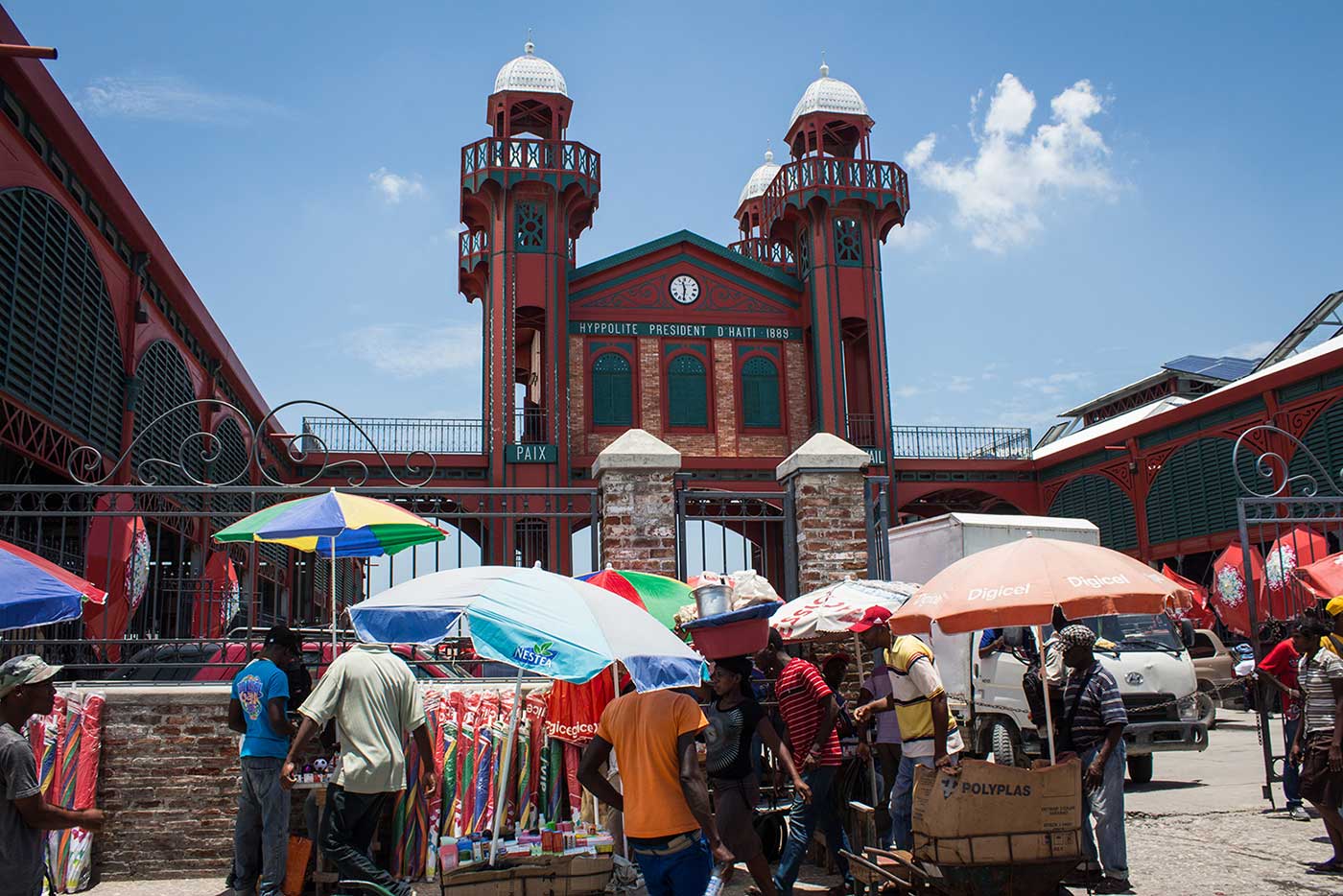

Pay them enough, and they’ll even put on a show. A few nights into the trip, our itinerary listed a real-life vodou encounter; the chance to witness a traditional Haitian vodou ceremony at a shack high up in the mountains. On paper, this experience was set to be the single highlight of the trip for me.
Vodou is a tradition of sacrifice: the loa do not appear without incentive. They must be summoned out with offerings, and different loa respond to different gifts. On this occasion, it seemed the loa being called had a particular fondness for cash. Our vodou priest was charging a high price for the show; and on top of that, our group was expected to provide the offering of fine rum, banknotes and cigars. The priest said some words, he burnt some herbs, he waved his hands… and nothing.
“The loa do not answer,” he explained. Sometimes the loa do not hear the call – other times the veil is drawn too tightly between worlds, and a more enticing offering must be made. In other words: more cash.

It was a fine business model. The cost of the event ran to roughly a month’s wages by Haitian standards – and after all, what had we expected? A first-hand encounter with a corporeal vodou deity? The Haitian vodou priest sang for us, and danced and said his prayers, but it wasn’t what I was looking for at all. This was not the vodou I had read about, but rather it was voodoo: a self-derogatory simplification of an age-old practice; cultural theatre for the uninitiated.
The problem was, as I was now beginning to realise, there was simply no way I’d see anything authentic so long as I was travelling in a group. Eight white faces in Haiti – we weren’t exactly discreet. Anywhere we went our presence was sensed a mile away. It felt as though any trace of real vodou culture was immediately hidden from us, spirited away for shame, for fear, or modesty, to be replaced by the clamouring attentions of street vendors and marketeers.
I decided it was time to cut the safety rope.

It was day three of the seven-day tour when I cut myself loose and ventured off alone into the Haitian vodou heartland. The rest of the group were heading to the beach – to drink cocktails and sunbathe on the Caribbean coast – but I had another destination in mind.
Just the night before, I’d got into a conversation with one of the staff at our guesthouse. I had asked him about vodou; whether there were real places of worship, true believers still practising in contemporary Haiti, or if the whole thing was little more than memory and spectacle.
“Oh, vodou is real enough,” he told me. “Just go down to the Grand Cemetery and you’ll see for yourself.”


The Grand Cemetery, or ‘Grand Cimetière’ of Port-au-Prince is a colonial-era burial ground located close to the city centre, tucked into the shadow of the southern hills. It was opened at the turn of the 19th century by Haiti’s former French overlords, and has since grown to include tens of thousands of tombs.
When the earthquake hit in 2010, it destroyed more than a quarter of a million homes here in the capital… but the older iron and stone structures of the cemetery survived largely intact. Soon the city’s homeless were turning to the necropolis, arriving in droves to break open the tombs, dragging out rags and bones to make room for blankets and children.
Today, the Grand Cimetière is home to the capital’s poorest and most desperate community – and it is in exactly these conditions, amongst death and desperation, that old folk superstitions flourish.
But there is a greater significance here, because Haitian vodou is a religion that finds fascination in death. Its rites often require bone and body fragments, with the strongest curses formed by using the remains of the victim’s ancestors. The city’s cemetery then, was already considered as a powerhouse of vodou energy; and now, repurposed as a shanty town, it had become a vodou city.
“You won’t actually go there, will you?” the man warned me. “It’s not a pleasant place.”
That morning I bid farewell to the rest of the group, and one hour later I was sat on the back of a motorbike taxi – speeding along the unfinished tarmac roads that wound down from our guesthouse in Delmas towards the port, the city centre, and onwards to the cemetery.
In a city where the roads are often no more than dirt tracks, narrow lanes crammed full of gridlocked 4x4s, delivery trucks, and hemmed in on either side with street markets that spill from the pavements to the tarmac, makeshift displays popping up in every available space, price-tagged tools and tinned fish stacked on display along the edge of car bonnets, while people – many of them balancing baskets on their heads – push and squirm, fighting for space as they force a path onwards through the chaos… a motorbike is the only way to travel.
My driver, Andre, was a local. He knew these roads, and drove us on with a confidence that at times appeared misplaced. He didn’t seem to touch the brakes once – even at times when the path ahead seemed blocked, heavy vehicles closing in from either side to crush us – Andre simply hit the gas and fired on through. My knees clipped wing mirrors. Palms and market fabrics brushed my face. More than once, I found myself holding my breath as the bike veered onwards through the impossible crowds and traffic, guided, it seemed, by faith alone.
Other times the markets fell away; we came upon a jackknifed lorry in the road, and Andre sent us veering out on a detour, looping wide through the suburbs of Port-au-Prince. We picked up pace and the city landscape flew by. From here the Tent City at Pétionville looked like a million coloured beehives, a colony of tents and chipboard, rising up out of the tropical vegetation.
By the time we reached the cemetery, my legs had turned to rubber. Andre spoke next to no English but like most Haitians, he could understand traditional French. It was a one-way process, though – while I found I could express myself well enough in the rusty French I’d barely used since school, anytime Andre replied, in the earthy, African tones of Haitian French Creole, I was lost.
Across the street stood a two-storey building, a guard house set around the large gates that marked the entrance to the cemetery; but the gates themselves were lost behind a busy throng of people. There were raised voices, women crying and two men in uniform, Haitian police, who stood watching the crowd with shotguns in their hands.
Neither for the first, nor the last time that day, I wondered if I was in over my head.
I approached the crowd slowly. My head was telling me to go back but my feet kept moving, setting a confident, even stride, denying me the luxury of retreat. By halfway across the road, all eyes in the group were on me… but before I could clear the distance someone was shouting at me, calling down from an upstairs window. In response a man broke away from the crowd, approached me, and gestured that I should follow him into the building.

The corridors inside were hectic as I was led up a flight of stairs, past Haitians who stopped and stared in surprise, until reaching an office at the far end. Here I was introduced to some kind of authority figure who sat behind a wooden desk. He waved his hand, and the two of us were left alone.
“What are you doing here?” he asked me, in French. I explained that I was a writer, and that I wanted to see the cemetery. “It’s impossible,” he said.
The tone of the conversation changed however, when I mentioned that I’d be happy to pay for the experience. We haggled for a while over a price, settling, at last, on 600 Gourds: about $12.
I slid the notes across the desk.
“Now give me 250 more,” he said. “For a guide.”
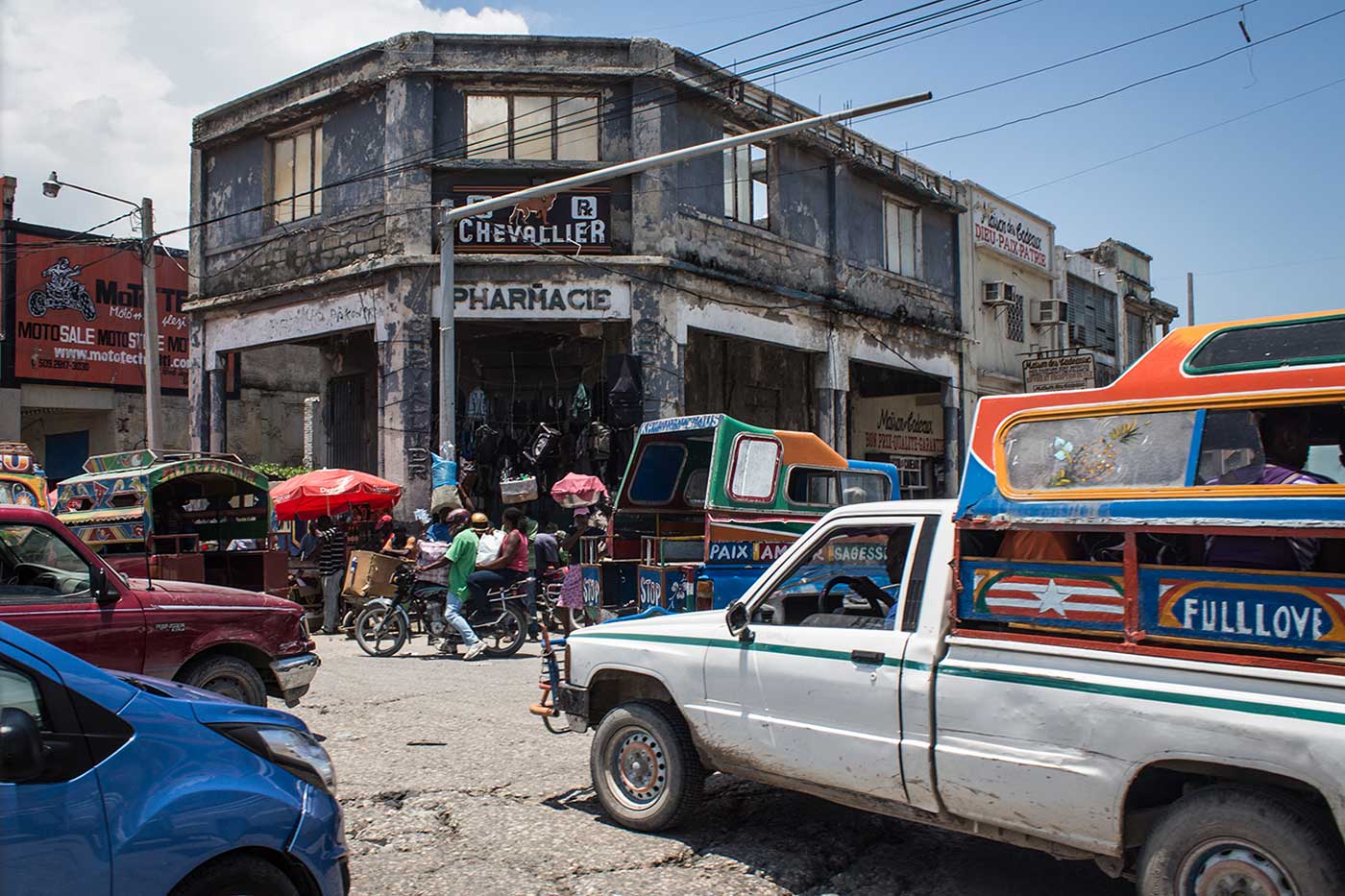
I tried explaining that I was happy to enter the cemetery alone, but it seemed this wasn’t an option; as it turned out, I wasn’t buying a guide so much as a bodyguard. The transaction was sealed with a spectacle of bureaucratic theatre – passports were checked, receipts signed, countersigned and rubber stamped – before the officer called out a name and the man who’d first led me in reentered. He was introduced to me as Sidney, a tall, hard-faced Haitian in perhaps his late fifties, who was to serve as my guide on this pilgrimage into the underworld.
Back at the gate, Sidney shouldered a path through the gathered crowd and I followed quickly in his wake. Someone called out from behind me and I turned to see Andre, my driver, hopping across the road towards us.
“I come,” he said, gesturing towards the necropolis.
The crowd parted and the three of us, Sidney, Andre and myself, passed from the streets of Port-au-Prince into the chaos of the cemetery.

The main thoroughfare of the necropolis felt little different to the suburbs of Port-au-Prince. Once we were past the gates, the guards and guns, the cemetery opened up before us in grid form. Residents floated here and there, speaking in corners or striding along the paths with baskets balanced precariously on their heads. The only difference, of course, was that here the city’s shops and markets, old brick walls painted up with hand-drawn advertisements, were replaced by tombs; row upon row of marble crosses and chipped mortar angels, a mass of memorials that faded away on either side into the shadow of the mountains.

Not far along this path, Sidney suddenly veered off into a gap between two tombs.
“Allons y,” he mumbled, in his stern baritone. Though he spoke rarely, and wore a tough-guy persona that was greatly enhanced by a deep-lined, weathered face marked with the tracks of old scars, I sensed a quiet humour about my guide; he was not unfriendly, though he gave off an aura of tolerance rather than camaraderie.
Away from the main drag, the tombs grew more chaotic – the paths less defined – and soon we were stepping across strewn chunks of broken stone, edging around the corners of semi-collapsed mausoleums. Sidney came to an abrupt halt before a weathered tree, that rose alone between two tombs. He gestured towards it, inviting me to make an inspection.


Atop the higher tomb, two men sat on the stone engaged in quiet conversation. They were dressed in leather jackets despite the heat, one man wearing a flat cap, the other with a shaven head and bare feet. I climbed up to join them, offering a nervous Bonjour as I did. The Haitians stopped talking, turned to look at me, and both broke into beaming grins.
“Byenveni,” said the man in the cap, a simple welcome in Haitian Creole, and his friend laughed. That’s when I saw the significance of the tree. Shielding my eyes against the sun, I took a closer look at the gnarled trunk – there were shapes pinned to it, small objects nailed into the bark all the way up. Dolls. Vodou charms formed from red and black cloth, which, from what I had read of the tradition, should each contain fragments of hairs, and bones taken from the graves of the target’s ancestors.
Even higher up the tree, the domes of human skulls broke out like carbuncles from the bark. These too, presumably, had been lifted from graves and nailed onto the wood; but for purposes of remembrance, for protection, or as some kind of psychic attack, I couldn’t say. I was already a little shaken as I hopped back down from the tombstone. After several days of theatre and distraction, such macabre evidence of contemporary Haitian vodou ritual was a lot to take in; but it nevertheless did little to prepare me for what I’d see around the next corner, as we headed straight into the heart of Port-au-Prince’s makeshift vodou city.
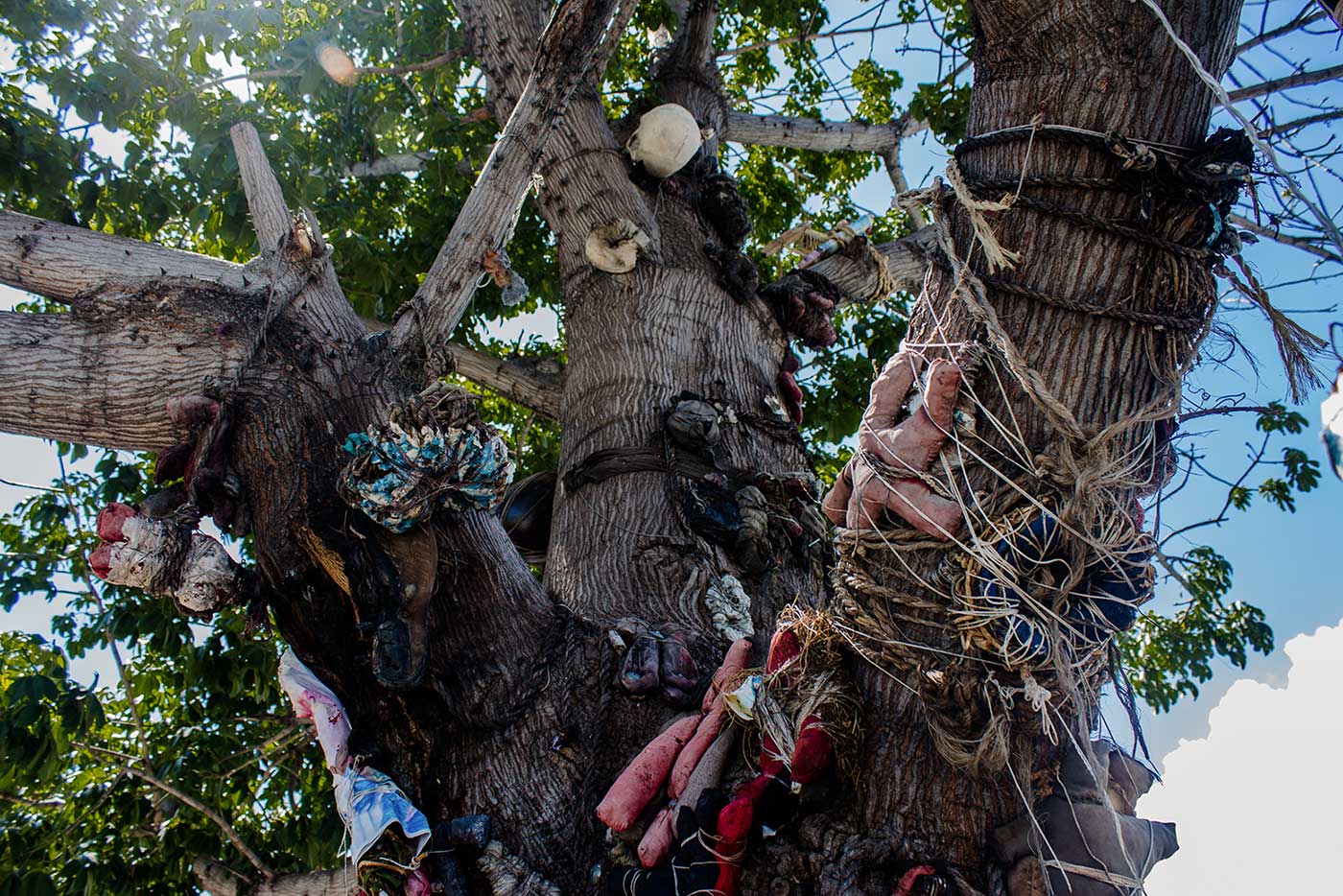
Following Sidney this way and that, Andre trailing behind me as we zigzagged between and around the tombs, our small party cut a hectic path through the necropolis. My feet caught on creepers and brick, the piling detritus of broken monuments fast giving way to nature. While many of the stone shells had suffered a gradual decline before the elements, others had been more aggressively razed; and some tombs had been flattened altogether by the quake. Others, here and there, showed the telltale signs of groping hands, prying tools, forcing open a portal to the burial chamber. In these repurposed mausoleums I would often spy blankets curled into a nest, shoes lined up outside; one time, even a pair of fleshy feet that hung out the end of a hollow tomb, attached, presumably, to the sleeping occupant.
We were coming closer to the heart of this community of grave dwellers. The tomb-cells grew more frequent, along with other signs of habitation: food waste, cigarette ends, even livestock such as goats and hens, that pecked or grazed quietly in the grass amongst the monuments.
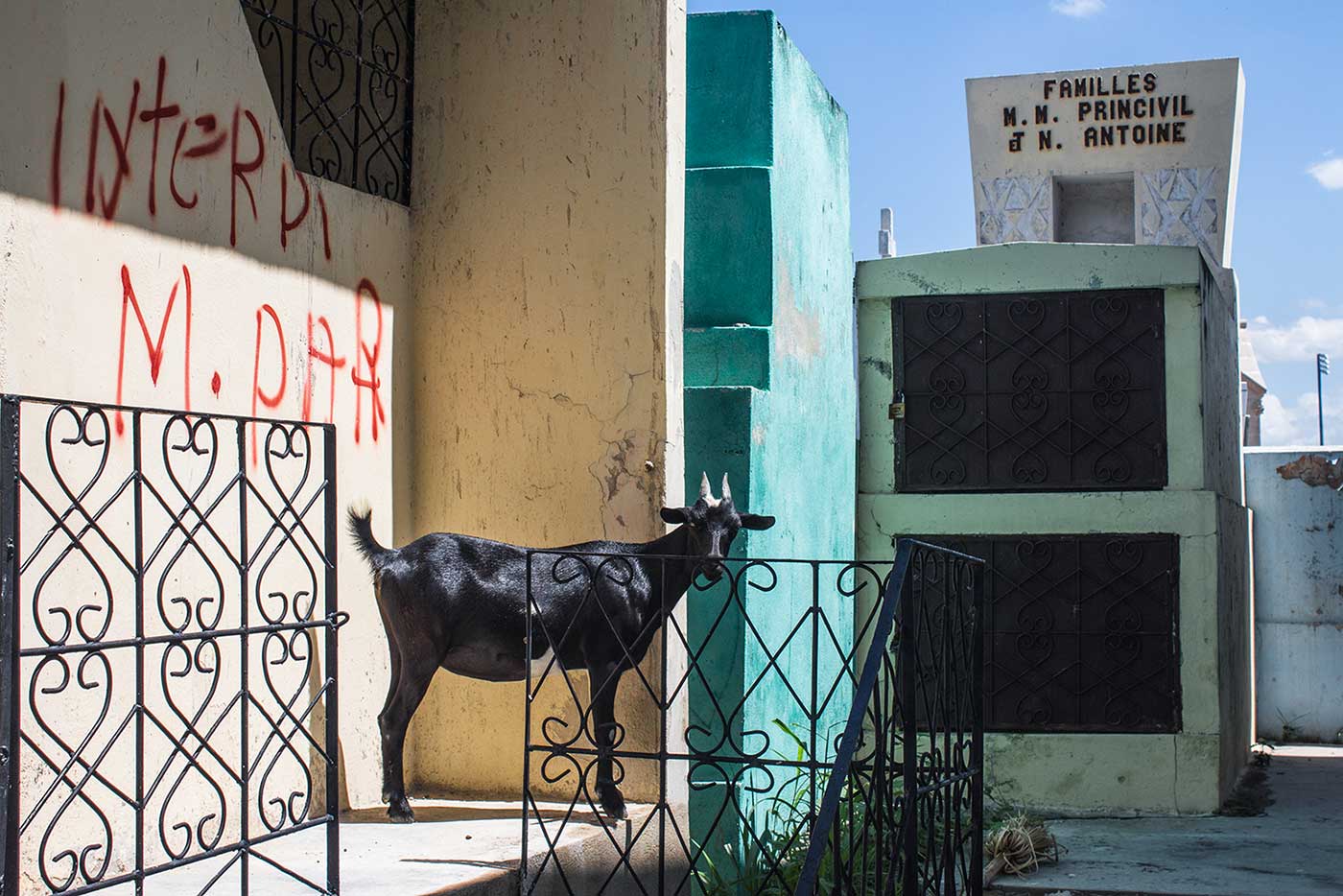

I heard the church before I could see it. A chorus of wails, the flapping of canvas sheets. We passed around one final corner and then, without warning, I was in the midst of it. Before us a marquee had been erected in a clearing between the graves. A service was in process: the congregation, largely dressed in white, rocked and cried beneath a roof of sails that ripped and tore in the wind. I saw them through the side of the tent, where the flaps were pinned open to form an entrance; and they saw me too.
A few of the worshipers stopped singing, momentarily distracted from their noisy lamentations by the sight of a visitor in the city of the dead. I was acutely aware of the concentrated power of their gazes – of the gazes, too, of those who gathered behind me, pedestrians, spectators, necropolis dwellers, all stopped in their tracks – a small crowd that was beginning to form around the spectacle of the foreigner at the Grand Cimetière.
Sidney dragged us away… but not so much towards salvation, as to delve deeper into the bowels of the cemetery; away from the church, away from the christian God, to meet instead with the vodou loa who dwelled amongst the shattered stones and black shrines of the necropolis.
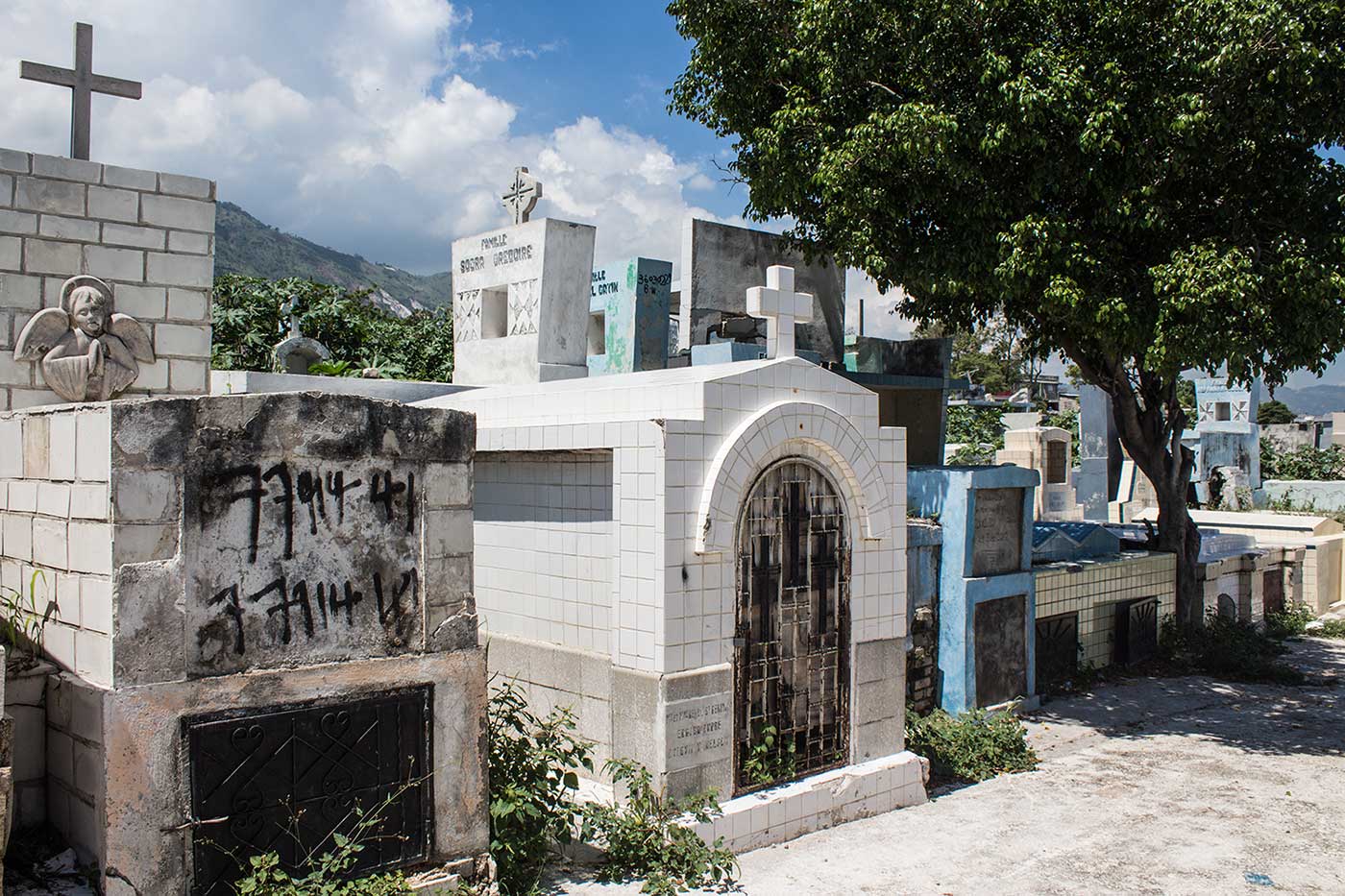
Away from the church, we wound through a series of noisy streets filled with all the life, the noise and the energy of a favela. Here the repurposing of the cemetery was at its height; in places the tombs were completely obscured behind tents, fabrics, makeshift homes pitched between the graves. I felt a strong urge to photograph the scene, but I resisted – this felt too raw, too personal. I resolved to focus on documenting the structures of the cemetery and perhaps those who interacted with them, while turning a blind eye to the homes of the dispossessed.

Not far from the church, my guide pointed me to a shrine. The jet black cross rose up from an unmarked grave, a simple icon covered with stains and cryptic scribbles. As I watched, a small group paid their respects – placing offerings before the cross as they muttered some kind of mantra.
“Le Baron,” Sidney told me. Baron Samedi.
For those not familiar with the Haitian vodou pantheon, Baron Samedi is considered ruler of the underworld. He is the loa of the dead, leader of the guédé, and typically appears dressed in funerary attire, with a skeletal face and top hat.
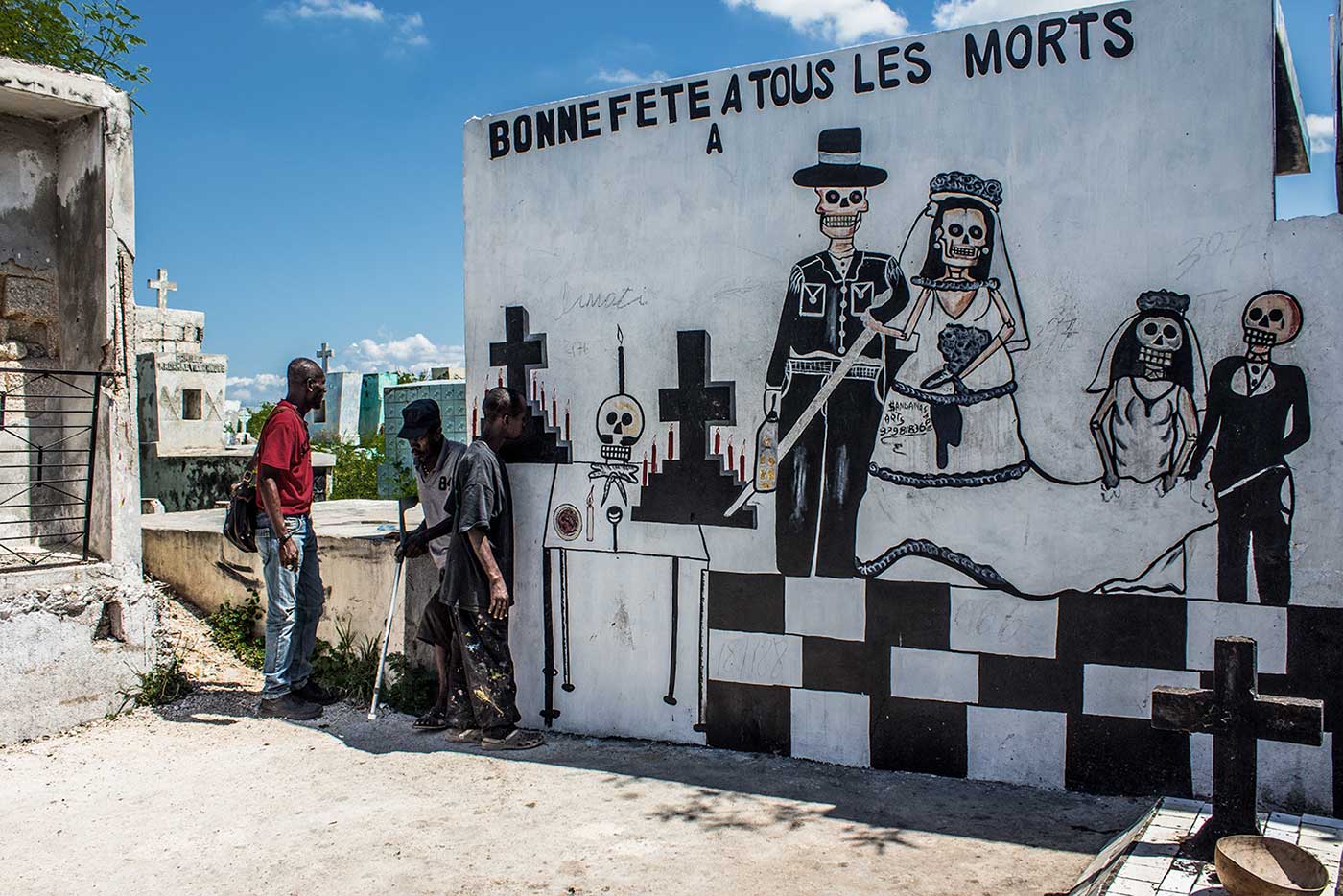
Beside the cross, something was written across the wall of a tomb in red paint. I took a closer look – it was dark and clotted, smeared unevenly with flies sniffing at the curved letters. It wasn’t paint. A woman was sat nearby, cradling a baby in her arms and she turned to look at me – mumbling first and then shouting, seemingly alarmed by the presence of a foreigner in such a hallowed place.
We left those shrines behind, to walk deeper into the labyrinth; but my presence had not gone unnoticed, and it was around this point that I realised we were being followed.
Several times I spotted a man dressed in a bright red shirt, who seemed to be trailing behind us at a distance. As Sidney and Andre led the way on through the maze, I began glancing back more often. There were two men following us now, their heads appearing and disappearing behind the stone rows – then a third as well, and all of them with their eyes fixed on me. They kept their distance, patient, observant, but by the time my stalkers outnumbered my guides I was beginning to feel uncomfortable.
Sidney pulled up suddenly, coming to a halt beside a shrine set into a recess beside the tombs. Behind a soiled cross, a figure had been painted onto the wall: a man with hat and lashing whip beneath the words, BARON KRIMINEL.
I had done enough homework on Haitian vodou to realise who this was. Baron Kriminel is the most fearsome of the guédé, a murderer and rapist in life who became a ferocious demon after death. Like all of the loa, he has his preferred sacrifice – a chicken dowsed in petrol and set alight – and when Kriminel rides his host, he sends them into a frenzy of slashing, spitting, biting and clawing.
I remembered that I still had a couple of Cuban cigars in my backpack. I’d carried them with me from Havana, and found they made an excellent gift for taxi drivers, security guards and the like. I reached in, showed them to Sidney, and asked if the Baron would like them.
I suppose I was hoping to bond a little with my guide. The less safe I felt in this place, the more keen I became to win him over; to present myself as a humble student, a friend rather than an outsider. And it worked – for the first time, Sidney broke out in a wide, toothy grin, and he nodded as he took the proffered cigars.

He approached the cross, bowing his head as he tied the offering up in the noted cords that hung from the crossbeam. I noticed then how the altar block was saturated in dark stains, the cross itself charred black not by paint, but fire. A single chicken feather rested in a patch of residue on the altar.
Sidney began to pray. I made out little more than a murmur, rapid words carried by deep breaths as he communed with the Baron. Then he stopped abruptly, turned, and smiled again at me.
“He waits,” he said, and for a moment I stood confused. Sidney gestured to the cross impatiently, urging me to approach it. I had expected him to make an offering, a symbolic token on my part to win a little favour in this seemingly hostile place. Instead, it appeared that Sidney had opened a portal to the underworld and summoned up Baron Kriminel for my own private audience. This was not part of my plan.

I approached the cross slowly, unsure quite how to address a Haitian vodou deity. It wasn’t that I expected to be communicating directly with an agent of the vodou underworld, so much that I was terrified to cause offence in this, their holy site. At least in Buddhist temples, at Islamic pilgrimage sites, there’ll usually be an information panel with a list of DOs and DON’Ts. Here I was alone though, in a very real and bloody place, with absolutely no idea how to proceed. Glancing briefly back, I saw Andre and Sidney watching me with eager, expectant faces.
So I spoke, quietly, I mumbled, but I made sure it was loud enough that my companions would realise I was playing the game. I asked Baron Kriminel for protection, and for safe passage out of this increasingly scary place. I thanked him and turned to leave – to Sidney’s sudden horror. He shouted and waved, gestured at me to knock on the wooden cross. I did, three times, before he explained to me in French:
“We knock to close the door. You don’t want this one coming home with you.”

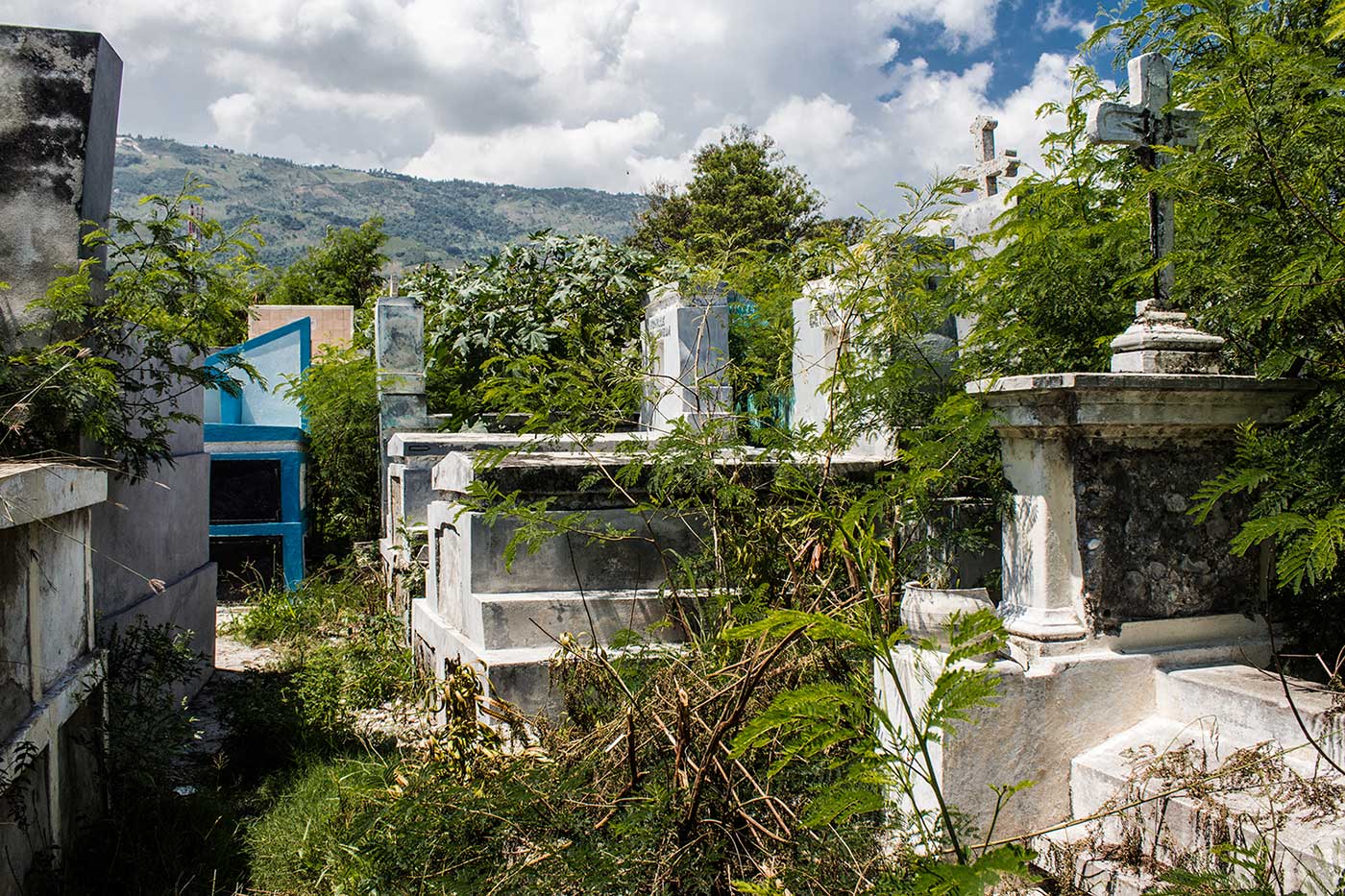
As the tour went on, I sensed that Sidney’s attitude to me had changed. He seemed more open, more chatty, and he happily pointed out some of the landmarks as we passed. One such sight was the devastated tomb of former Haitian dictator, ‘Papa Doc’ Duvalier.
The white brick structure was in ruins. In life, Papa Doc had marketed himself as the living incarnation of Baron Samedi; he even took to dressing the part, using Haitian vodou superstitions to fuel his growing cult of personality. He was buried here at the Grand Cimetière in 1971, and when his tomb was ransacked 15 years later – during the 1986 Haitian Revolution, an uprising against his son, Jean-Claude ‘Bébé Doc’ Duvalier, and the political legacy of Duvalierism – the legend has it that his body had mysteriously disappeared.

Not far off, we passed a series of open tombs. The graves had been smashed open from one end, a series of rags and bones strewn about in the vines that spread to reclaim the scattered bricks. Sidney told me that the bodies had been burnt; when the first grave dwellers moved in after the 2010 earthquake, coffins and their contents were piled unceremoniously into bonfires to make room for new inhabitants.
Around the next corner, he pointed out the remains of one of these pyres: the ground scorched black at a crossroads amongst the graves.

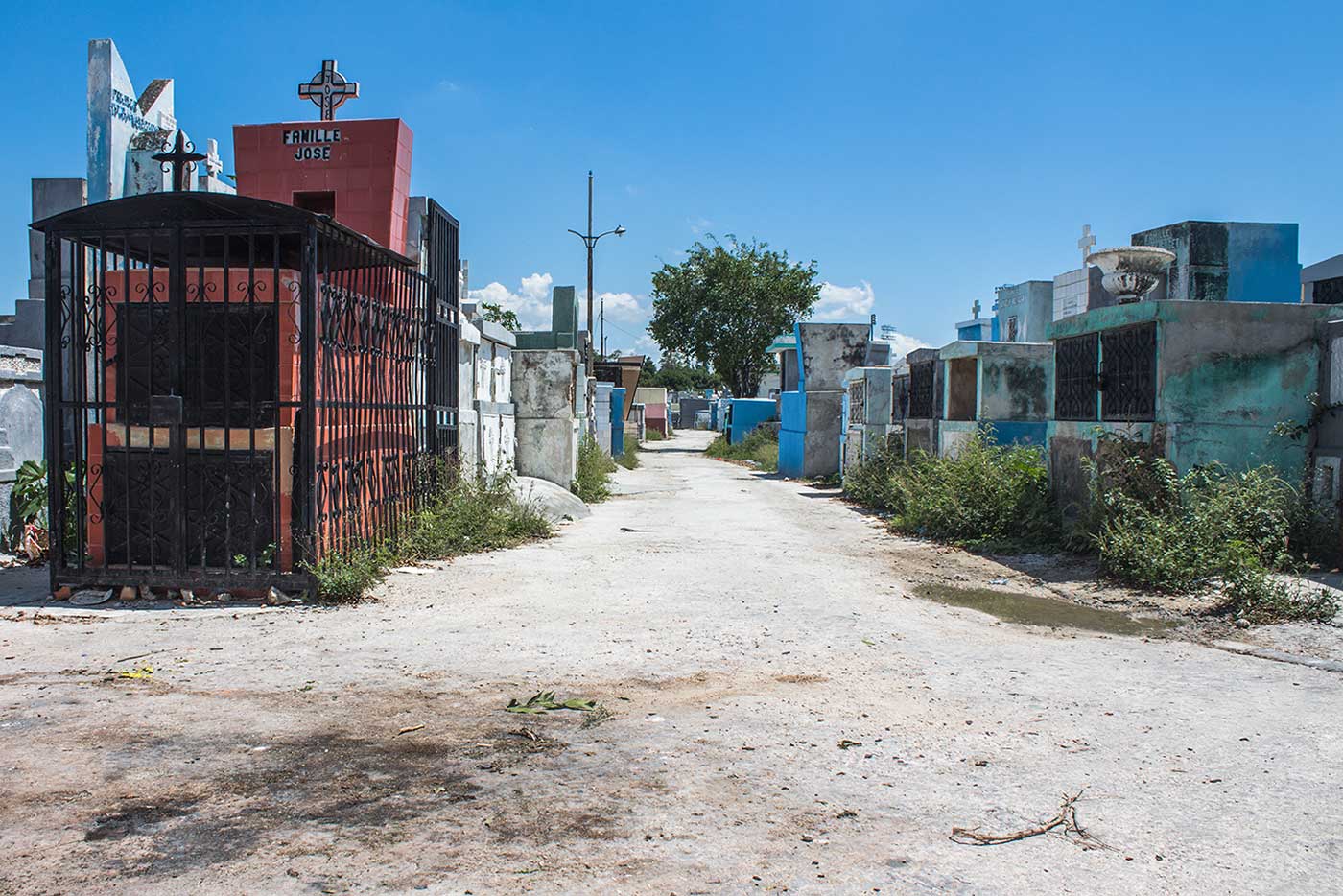
While I was still contemplating those burn marks, the grave stalkers caught up with us. I felt a tug at my sleeve, and turned to see the man in red stood just behind me. He pointed at his mouth, and at his belly; there were others behind him though, and as much as I wanted to help I was afraid to take my wallet out in such an unpredictable place. I shook my head uncomfortably, but he was insistent. He slapped my arm and made the same gestures again, this time with aggression. The others were closing in, and now there were three of them stood around me.
Sidney had been scouting on ahead, but when he saw what was happening he came dashing back, shouting at the men and admonishing them with arms raised. I felt an indescribable sense of awkwardness.

I was ready to leave this place behind, but the cemetery had one last surprise in store. Following Sidney on through the weaving passages of grass and rubble, hopping over slabs, skipping tree roots where they broke out of the soil in warped tentacles, I turned a corner and ran head first into a naked woman. Apparently I was more embarrassed than she was; she even laughed, when my hands instinctively recoiled from my camera in an automatic demonstration of innocence.
They were three women and a man, stood in a grassy clearing amongst the graves. The man was offering a prayer while two of the women stood solemnly at his side, naked head to foot, their clothes folded in a pile beside the stones. The third woman bent behind them, drying herself off with a towel. In front of them meanwhile was a crypt, containing a tiled mausoleum whose end had been smashed open to reveal a dark, gaping space within.

As I watched a pair of hands suddenly appeared from inside, clutching up at the edge of the precipice. They pulled and a head followed after, trailing long, wet hair – another woman was climbing up and out of the water-filled grave beneath the monument.
Sidney turned to me and smiled. He explained that bathing with the bones of one’s ancestors is known to bring good fortune.
It was time for me to leave; but just before we reached the entrance to the cemetery, my guide pulled me aside into a clearing between the stones. Sidney was looking for a tip, of course, and I paid him gladly. Andre and myself left the necropolis behind after that, passing out of the crowds, past the guards, before climbing onto his bike and cruising back through the streets and markets, back towards the peace and security of my guesthouse. Back to the mortal realm.
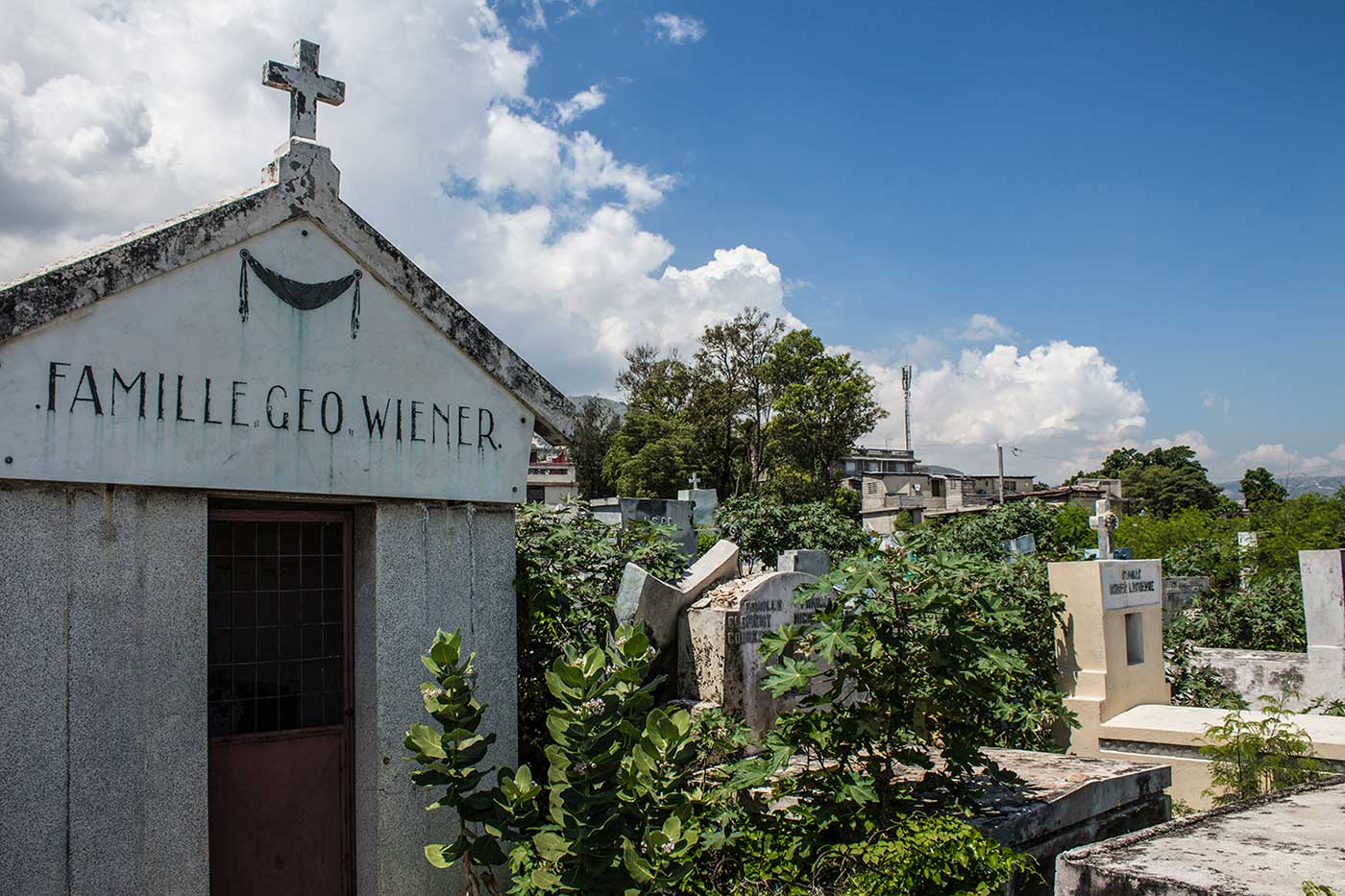
I went looking for Haitian vodou… and I found it. Given the nature of what I saw though, I very nearly didn’t write this article. I’ve written about disasters before, and I’ve written about death. It’s harder though, to write about life in the wake of a disaster; and visiting the Grand Cimetière, for me, raised a number of difficult ethical questions.

Here in Haiti, the poorest nation in the Western hemisphere, the old ways still provide a crutch that many reach for out of desperation. Superstition flourishes in such conditions and while a conservative practice of vodou may be more widespread in Haiti, I had seen it here in a jarringly raw form.
I went to the necropolis because I was curious about Haitian vodou – and I’ve written about my experiences there because I believe other people might share that curiosity. But while navigating the complex morality of what some might classify as slum tourism, I was careful to observe a few key principles:
I didn’t photograph homes.
I didn’t photograph children.
I didn’t photograph human remains, unless it was important to the narrative.
I didn’t photograph anyone who made it clear that they were offended by my presence.
When people indicated that I was unwelcome, I simply put my camera away and moved on.
While I found the theory and rituals of Haitian vodou fascinating, it should be remembered that these disadvantaged people are turning to ritual sacrifice because nothing else has worked for them so far. Haiti needs help. It’s getting some already, but nowhere near enough – and too often the funds get lost along the way, absorbed by international agencies, bureaucrats and greedy officials. So while this article may ostensibly be about a cemetery in Haiti and the seemingly scary things that go on there, I hope it also serves to raise some awareness of the underpinning humanitarian issues too.





An illustrated guide to urban exploration in the Russian capital.

Poltergeists, ritual murder & a live-in succubus – the 1000-year-old pub with a ghostly reputation

A month-long monument hunt, and what I learned along the way.
I had been to Haiti 3 times over 40 years ago .. and I still remember the gentleness of the people. thank you for the respect you showed while sharing your journey
I am from Dominican Republic (aka best Haiti enemy) I know my country is angry with Haitian culture and the voodoo practice, but I believe every country has its own way, and maybe for be so closer we close to them, but I am doing a difference, my boyfriend is Haitian and I am learning more about this country than him, I just found out this narrative looking for Daddy Doc crypt, and I really enjoyed to read to you, I have a big phobic to cemeteries but I was not so scary reading to you!
Thank you for posting this most interesting narrative about this cemetery. It is clear that so much has been lost to time and wear there. Yes, it was an interesting read.
Really enjoyed it!
Most interessting reading which I googled following reading a story on Papa Duc
They say that Jean-Claude removed his father’s remains and flew them out of the country with him, before the crowd could get there. French TV showed the corpses of old Duvalier officials being dragged out of the tombs and the bones thrown into the gutter. I knew one of these men, Breton Nazaire, who was Interior Minister when I lived there in 1972, he was in cahoots with a crooked Haitian priest who wanted to “nationalize” my little leather handbag factory. He kept promising to give me the work permit I needed but never did, and I had to flee the country myself. They say he died of an overdose of aphrodasiacs (that was before Viagra) while in a hotel room with a young prostitute. I enjoyed seeing his dried-out corpse on TV, I can assure you! Revenge is a dish you can enjoy cold as well as hot!
Thank you for sharing this, Lawrence, it’s all very interesting. My time in Haiti was very short, and I regret that I didn’t learn as much I would have liked about more recent history. I will have to come back sometime…
Coming from a country very close to Haiti (and sharing a somehow similar heritage as a nation) I must say that I’m very touched by your ethics and respect, your words say a lot more of this visit that your photos. Thanks for daring to see the real misery without displicence and for sharing it in such a humble and sober manner. You are a fabulous storyteller.
I spotted several “franc-maçon” tombs… interesting (not surprising however) 😉
Thank you very much – as I mentioned in the reply below, this wasn’t an easy piece to write. It’s obviously a very delicate subject, so I’m pleased to know that you felt this handling of it was acceptable. Thanks for the feedback – I appreciate it a lot.
And yes – there were a very large number of masonic tombs there. It makes me wonder if there is any continuation of the masonic tradition in Haitian culture today, or whether, as is the case with Christianity, there are places where elements of masonic tradition have been adopted into vodou practice? Perhaps that’s something to look into on a future visit…
This was one of the most fascinating posts I’ve come across in a while. Images of voudou practice in a present day Haiti graveyard will probably never be that available on the web or elsewhere, let alone a cemetery where people have been forced to live in. I’m guessing in Port-au-Prince this might be one of the largest in the country? That might be hard to find out short of an old travel guide I imagine.
Your comments about slum tourism make sense in the context of your blog. I would absolutely go here for the same reasons that you did. I never really thought of this concept when I travelled in India or had an opportunity to take pictures when I served in Afghanistan.
On the other end of a detached, voyeuristic-tourism spectrum is our inability to empathize with others until they become humanized. This is the power of photography and one of the most effective forms of activism. Your words and images combined are humanizing and stories like this one really should be told. I could see the non-tourism version of this in a magazine like National Geographic, for example. It feels like a story that needs to be told.
Thank you, Shannon. I’m very grateful for your comments, and I am glad that you felt this piece was justified. When I saw this place, I knew I wanted to write about it – but there are so many ethical problems attached to the representation of poverty, that it felt like I was walking into a minefield. Unsurprisingly, I’ve had some negative feedback too… but perhaps more so than any other piece on this website, here I felt that I had to take more of a journalistic (rather than touristic) approach.
Like you say, I think people need to be aware of this situation. In the end I decided that being a little intrusive with my photographs (which in itself felt very uncomfortable for me – I usually photograph architecture!) was an appropriate way of sharing what I saw of the place.
Well, anyway, thanks again for the feedback. I’m very glad the piece had the result I hoped for, and that it didn’t come across as too voyeuristic.
Amazing read. I love cemeteries and the evolution of Afro religion and its syncretism in the diaspora. I would have never thought to do this but it is definitely in my to do list on my visit to Haiti. As a budding blogger and travel photographer I loved reading your opinion on slum tourism. I visited a favela in Brasil and would not take out my camera until my guide urged me to take photos. It felt rude to photograph people’s daily lives but your rules offer a great starting point coupled with intuition.
Leo, thanks a lot for this comment. It certainly was a difficult place to write about – and the fact that some people there objected to my presence really did raise a lot of ethical questions for me. The rules I suggested here were simply based on my own feelings of what was and was not appropriate, but I felt it was important to give it some thought and explanation. I haven’t been to Brazil, as you have, but I’d imagine there are similar issues to consider there. I’m very glad you found this interesting though, and I appreciate the thoughts!
A fantastic and extremely compelling article. I’ve often been intrigued, like many others, about the vodou practices in Haiti, but I doubt I would have had the courage to embark on the journey that you made – or to stick with it once you clearly realised how dangerous it could have been. Top marks on the Cuban cigars idea, too!
Thanks so much Flora, and I’m really glad you appreciated this. To be honest, I’m not sure how much of it was courage, and how much naivety – I definitely didn’t expect things to turn out the way they did, but once there, I guess the journalist in me couldn’t quit the place.
I actually took a lot of grief about that cigar thing later on, from some Christian friends. They accused me of worshipping false gods. I never thought about it that way at the time, but it was certainly a memorable experience!
Great article , good get a real sense , thank for being courageous enough to go there.
You’re very welcome! I’m glad I managed to get the feel of the cemetery across – it was a really atmospheric place to visit, and unlike anywhere I’ve been before.
you lost me when you said christian , their not turning anything , this is their original tradition , that which has been handed down , and much older then most beliefs we have today .
Hi Alma, thanks for the comment. I’m not sure I understood you, though – which did you think I said came first? I didn’t mean to suggest either order of events, actually.
It’s my understanding that vodou has incorporated elements of the Christian cosmology into a much older cultural tradition, which I think is the case you’re arguing here? If so, we agree!
Very interesting. some photos can almost tell a story, some tombs are very decorated and others just plain. Thank you for posting.
Absolutely – there’s so much you can read from the state and design of these tombs. Usually, when I write about cemeteries, I spend a lot more time looking at the symbolism and names on the tombs… there was so much going on in this place though, that I didn’t even get as far as the standard analysis! Anyway, thanks for commenting.
This was such a great read! Sometimes I can get discuraged by long posts like this one, since english is not my first language and it can be difficult to keep the focus, so I often just jump from paragraph to paragraph or read throughout the day, but I read this one in one sitting. Things like this and experiences like this really fascinate me. I’m not sure if I would have the balls for something like this, but I love reading aout it. And I really like how you write about it – with utmost respect and so raw.
It certainly is a long post… originally I was planning to publish this as three separate articles, but once I started writing it the story told itself. I’m glad you gave it a go, and I’m even happier to hear that you enjoyed it so much! Thanks a lot for taking the time to read and comment.